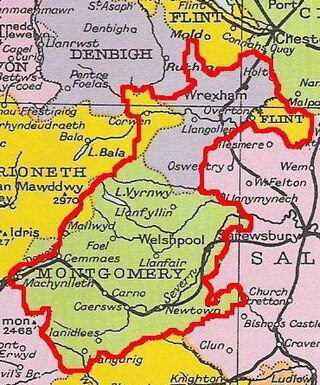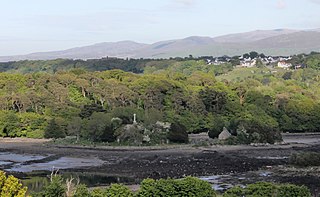
Gruffudd ap Cynan, sometimes written as Gruffydd ap Cynan, was King of Gwynedd from 1081 until his death in 1137. In the course of a long and eventful life, he became a key figure in Welsh resistance to Norman rule.

The Kingdom of Powys was a Welsh successor state, petty kingdom and principality that emerged during the Middle Ages following the end of Roman rule in Britain. It very roughly covered the northern two-thirds of the modern county of Powys and part of today's English West Midlands. More precisely, and based on the Romano-British tribal lands of the Ordovices in the west and the Cornovii in the east, its boundaries originally extended from the Cambrian Mountains in the west to include the modern West Midlands region of England in the east. The fertile river valleys of the Severn and Tern are found here, and this region is referred to in later Welsh literature as "the Paradise of Powys".

Meifod, formerly also written Meivod, is a small village, community and electoral ward seven miles (11 km) north-west of Welshpool in Montgomeryshire, Powys, Wales, on the A495 road and located in the valley of the River Vyrnwy. The River Banwy has a confluence with the Vyrnwy approximately two miles (3.2 km) to the west of the village. The village itself had a population of 317. The community includes the village of Bwlch-y-cibau and the hamlet of Allt-y-Main.

Madog ap Maredudd was the last prince of the entire Kingdom of Powys, Wales. He held for a time, the FitzAlan Lordship of Oswestry, family of the Earls of Arundel, of Arundel Castle. His daughter married Lord Rhys, prince of Wales.
Cyngen ap Cadell or also (Concenn), was King of Powys from 808 until his death in 854 during a pilgrimage to Rome.
Elisedd ap Gwylog, also known as Elise, was king of Powys in eastern Wales, son of Gwylog ap Beli.
The Battle of Chester was a major victory for the Anglo-Saxons over the native Britons near the city of Chester, England in the early 7th century. Æthelfrith of Northumbria annihilated a combined force from the Welsh kingdoms of Powys and Rhôs, and possibly from Mercia as well. It resulted in the deaths of Welsh leaders Selyf Sarffgadau of Powys and Cadwal Crysban of Rhôs. Circumstantial evidence suggests that King Iago of Gwynedd may have also been killed. Other sources state the battle may have been in 613 or even as early as 607 or 605 AD.
Cynan Garwyn was king of Powys in the north-east and east of Wales, who flourished in the second half of the 6th century. Little reliable information exists which can be used to reconstruct the background and career of the historical figure. Available materials include early Welsh poetry, genealogies and hagiography, which are often late and of uncertain value.

Saint Tysilio was a Welsh bishop, prince and scholar.

Church Island, also known as Llandysilio Island, is a small island in the Menai Strait on the shores of Anglesey to which it is attached by a short causeway that is reachable only on foot. The dominant feature of the island is with St Tysilio's Church, constructed in the 15th century, its churchyard, and a grade-II listed war memorial. The 20th-century bard Cynan is among several notable people buried in the churchyard. The Anglesey Coastal Path passes the head of the causeway.
Saint Dunod was the first Abbot of Bangor Iscoed of north-east Wales.
Selyf ap Cynan or Selyf Sarffgadau appears in Old Welsh genealogies as an early 7th-century King of Powys, the son of Cynan Garwyn.
Cyngen Glodrydd was an early 6th-century King of Powys. He was a descendant of King Cadell Ddyrnllwg. Cyngen married St. Tudlwystl, a daughter of Brychan ap Gwyngwen ap Tewdr and they were parents of a large family: Brochfael Ysgithrog, Cadell, Ieuaf, Maig Myngfras, Mawn and Sanan. What is probably his memorial stone was discovered being used as a gatepost in Tywyn (Gwynedd) in 1761. He was apparently buried with St. Cadfan in the local churchyard.
This article is about the particular significance of the century 1101–1200 to Wales and its people.
This article is about the particular significance of the century 1001–1100 to Wales and its people.

The history of Gwynedd in the High Middle Ages is a period in the History of Wales spanning the 11th through the 13th centuries. Gwynedd, located in the north of Wales, eventually became the most dominant of Welsh polities during this period. Contact with continental courts allowed for Gwynedd to transition from a petty kingdom into an increasingly sophisticated principality of seasoned courtiers capable of high level deplomacy and representation; not only with the Angevine kings, but also the king of France and the Papal See. Distinctive achievements in Gwynedd include further development of Medieval Welsh literature, particularly poets known as the Beirdd y Tywysogion associated with the court of Gwynedd; the reformation of bardic schools; and the continued development of Cyfraith Hywel. All three of these further contributed to the development of a Welsh national identity in the face of Anglo-Norman encroachment of Wales.

St Chad's Church in Shrewsbury is traditionally understood to be founded in Saxon times, and King Offa is believed to have founded the church, though it is possible it has an earlier foundation even than that.

The Montgomeryshire flag refers to proposals for a flag of the Welsh county of Montgomeryshire. Neither has been registered with the Flag Institute.

Bryneglwys is a village and community in Denbighshire, Wales. The village lies to the northeast of Corwen on a hill above a small river, Afon Morwynion, and is situated in the ancient commote of Iâl (Yale). The community covers an area of 9.45 square miles (24.5 km2) and extends to the top of Llantysilio Mountain. It had a population of 369 at the time of the 2011 census, an increase from 344 during the 2001 census.










